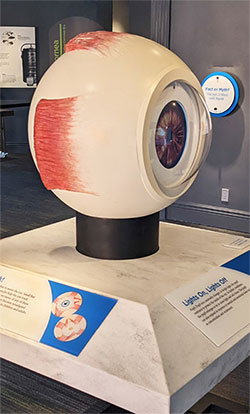Download PDF
Imagine a place where people of all ages can embark on a journey of discovery about the eye, the science of sight, and the history of ophthalmology.
This vision has become a reality, thanks to the generosity of Stanley M. Truhlsen, MD, Michael F. Marmor, MD, and other visionary donors. Nearly 70% of donors are Academy members. The museum thanks them and the corporate partners who helped meet the $12 million fundraising goal.
The Truhlsen-Marmor Museum of the Eye is unique. It is the only free, public museum dedicated to the exploration of sight and the profession of ophthalmology. The museum aims to:
- deliver an interactive exploration of vision and the eye,
- preserve the rich history of ophthalmology and vision scientists,
- celebrate and inspire innovation in eye care, and
- promote eye health on a broad scale.
After COVID-19 delayed its 2020 opening, the Truhlsen-Marmor Museum of the Eye is now welcoming visitors.
A Museum for Everyone
Few subjects are so widely relevant as vision. Sight, central to most individuals’ experience of the world, is often considered to be the most valuable of the senses. Thus, the museum has a broad appeal across all ages and backgrounds. Located in San Francisco’s bustling Fisherman’s Wharf neighborhood, the museum draws visitors from the United States and around the world.
Showcasing Rare Art and Artifacts
Many Academy members have had glimpses of the museum’s holdings at the annual meeting exhibits. Yet these displays could only hint at the vast 38,000-object collection. The scope of the museum’s collection is difficult to grasp, encompassing eye- and vision-related materials ranging from antiquarian medical tomes and glasses made from whale baleen and quartz crystal to Egyptian amulets, and from religious objects to sophisticated ophthalmic instruments.
Previously, these items could be seen only by appointment or online. Now, the beautiful new galleries allow a rotating selection of these rare artifacts displayed in a meaningful context.
Beyond the Objects
The Museum of the Eye is much more than an impressive collection of objects. It is designed as an immersive experience that uses cutting-edge technology to intrigue, educate, and delight visitors. Through virtual reality headsets and interactive screens, visitors are able to take a virtual “walking tour” through the eye, visualize the effects of blinding eye diseases, get a 3-D view of the latest operating microscopes, and much more.
The museum appeals to all ages. Exhibits have been designed to fascinate adults and families. Several displays and docent tours are geared toward California public education standards, making school groups welcome.
Honoring the Profession
From bold surgeries to life-saving care, ophthalmology has played a remarkable role in the history of medicine and society. The profession’s exciting technical innovations and visionary leaders have improved the lives of generations of patients and defined the science of eye health.
The Museum of the Eye aims not only to preserve the heritage of ophthalmology, but also to develop greater public awareness of the profession. It honors the great ophthalmologists of the past and present and, in doing so, may inspire interest in medicine and eye care among new generations of young visitors.
Aligned with the mission of the Academy. By inspiring curiosity and awe about the eye and vision, and helping visitors understand the workings of the visual pathways, the museum drives forward the mission of the Academy: protecting sight and empowering lives. All Academy members can take pride in this showcase of the past, present, and future of ophthalmology.
Learn more and visit. The Truhlsen-Marmor Museum of the Eye is located at Academy headquarters in San Francisco. For directions, hours, and reservations for timed entry, check aao.org/visit-museum.
A Closer Look at the Galleries
The museum has been designed to provide a natural flow through several galleries devoted to different aspects of anatomy, visual function, ophthalmic history, and future developments. Here’s a closer look inside.
Gallery 1: Anatomy. Gallery 1 is an introduction to the anatomy of the eye and its function. Among the highlights is a large model eye with multiple interactive elements that allow visitors to experience the effect of light on the pupil and to get a close-up view of the interior structures of the eye. Other interactives include a stereoscope and demonstration of our blind spot. A 3-minute video presentation illustrates how the eye focuses and what lenses do to help our vision. Historical artifact cases highlight the evolution in our understanding of the eye’s anatomy and its function.
Gallery 2: Power of the Retina. This gallery takes a deep look at the layers of the retina at the back of the eye and how it codes information for our brains. Photoreceptors, visual pigment, the visual spectrum, and color deficiency are all discussed. Families can have fun with a zoetrope and optical illusions selected to demonstrate how the eye uses contrast to “read” our surroundings.
Gallery 3: Advancements. Gallery 3 takes visitors on a time trip through the development of medicine from ancient times to contemporary state-of-the art visual science. Starting with the medicine of ancient Egypt, China, and the Indus Valley, the storyline continues through to diseases of the retina and cornea, and to strabismus and glaucoma. Instruments from different centuries are coupled with touchscreens that provide timelines and biographic sketches of physicians and famous individuals connected with ophthalmology.
Gallery 4: Innovation for Sight. This gallery takes the story further by exploring some of the newest ideas and technologies that are changing the practice of ophthalmology. Video stations show films of imaging techniques, while displays discuss microsurgical techniques, the latest biological materials, and gene editing therapies. Visitors are able to use a 3-D microscope, take a journey in virtual reality, and see how ophthalmology has empowered patients’ lives.

AN INSIDER’S VIEW. The interactive eye model gives visitors a unique opportunity to experience the anatomy and functions of the human eye.
|